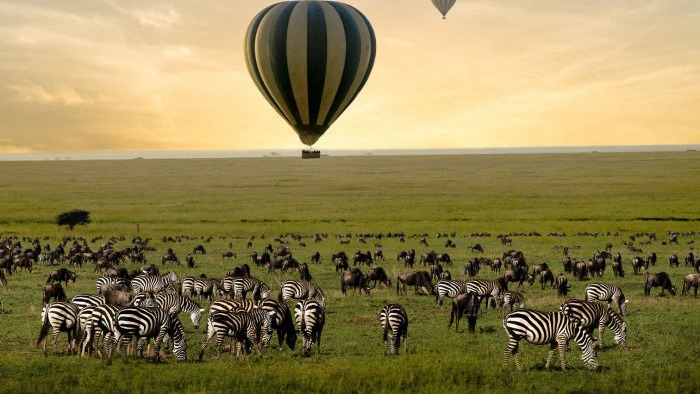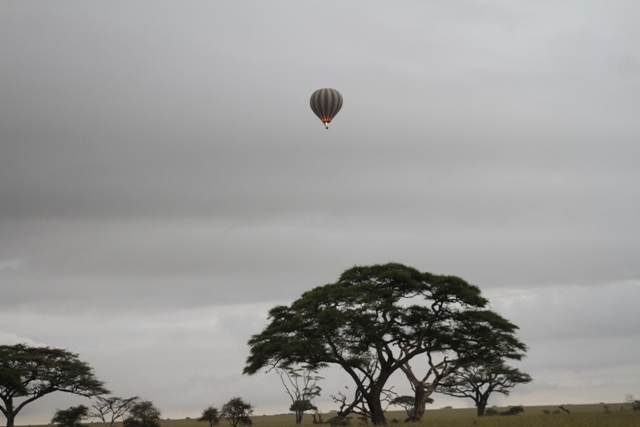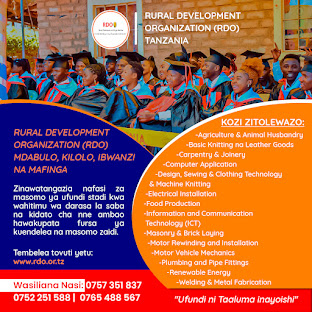By Matukio Daima media
This balloon safari at Ruaha National Park, located in the Iringa region of the Southern Highlands, has significantly enhanced tourism by attracting a large number of visitors.
It is possible that the improvement of tourism infrastructure in Northern Parks is a primary reason for attracting tourists. If that is the case, efforts are now underway at Ruaha National Park, so we expect to see a pace of tourists in Northern Parks aligning with those in the South, particularly Ruaha.
You might wonder why balloon safaris have been chosen as a major attraction during the 60th anniversary of Ruaha National Park?
The answer is that Ruaha National Park is one of Tanzania's major tourist attractions, playing an essential role in the nation's heritage.
As this park celebrates its 60th anniversary since its establishment, it is important to recognize that Ruaha National Park, located in Iringa District, Iringa Region, is the second largest in Tanzania, covering an area of 19,822 square kilometers. The park is rich in diverse plant and animal species, attracting visitors from all over the world.
This unique combination of environments and abundant biodiversity places Ruaha high on the list of top tourist parks in the country.
The park has not lagged behind in innovating ways to attract visitors, with hot air ballooning now being a significant part of the 60th-anniversary celebrations.
However, it is important to understand the history of this balloon tourism and its significance in the development of the tourism sector.
It should be noted that balloon tourism is relatively new to Ruaha National Park, but it is not a new concept globally. It began in the 18th century when the French brothers Joseph-Michel and Jacques-Étienne Montgolfier invented the first hot air balloon in 1783.
Their first experiment opened doors to aerial travel, ultimately leading to this form of tourism.
In the years that followed, balloon technology improved, and this type of tourism became increasingly popular in natural areas and wildlife reserves around the world.
In Tanzania and its neighbor Kenya, balloon tourism began to be more utilized in the Serengeti and Masai Mara reserves.
Tourists were able to witness the landscape of wildlife from the air, attracting many visitors.
In other areas, such as the Sahara Desert and Cappadocia in Turkey, balloon tourism has become popular due to the unique landscapes and natural beauty visible from the sky.
In recent years, balloon tourism has continued to grow due to technological advancements and increased safety measures.
This has heightened the interest of both international and domestic tourists who wish to explore the wildlife landscape and natural environment from above.
Ruaha National Park boasts a vast array of wildlife, including lions, elephants, buffaloes, and zebras, among others.
The launch of balloon tourism offers visitors a unique opportunity to witness these stunning landscapes from above.
For tourists who enjoy a different perspective on wildlife, balloon tourism will provide an experience unattainable by vehicle.
The Park Warden, Senior Assistant Commissioner Godwell Ole Meing’ataki, explains that this new balloon tourism aims to increase the number of tourists visiting Ruaha and contribute to the park’s and government’s revenue.
Unlike vehicle tourism, which can disturb wildlife, balloons provide a silent and non-intrusive experience, allowing visitors to see wildlife in its natural state.
According to Meing’ataki, balloon tourism will also contribute to the increase in unique photos and videos that tourists will capture, which is expected to inspire more tourists to visit Ruaha.
Moreover, balloon tourism will stimulate the growth of tourism-related businesses, such as hotels, restaurants, and transport services.
During the 60th-anniversary celebrations of Ruaha National Park, various activities targeting the surrounding community, alongside religious and traditional leaders, took place.
This park is not only a major source of revenue for the Iringa region but also a significant source of employment for residents living near the park.
This unique event, which started on October 1 and ended on October 7, 2024, was concluded by the Minister for Natural Resources and Tourism, Ambassador Dr. Pindi Chana.
Minister Ambassador Dr. Chana stated that since its establishment, Ruaha National Park has achieved significant successes, including an increase in tourist numbers from 9,657 in 2020/2021 to 19,332 in 2023/2024.
“These tourism successes have largely been contributed by the efforts made by President Dr. Samia Suluhu Hassan in promoting tourism and our attractions through the country’s most popular film ‘Tanzania: The Royal Tour’ and the film ‘The Amazing TANZANIA,’” emphasized Dr. Chana.
She elaborated that following President Samia’s efforts, in the 2023/2024 fiscal year, the number of international tourists in the country increased by 96% from 922,692 in 2021 to 1,808,205 in 2023.
Regarding the improvement of tourism infrastructure within Ruaha National Park, Dr. Chana stated that the government, through the REGROW project, is in the final stages of constructing two modern high-standard airstrips in the Ukwaheri area in the southern part of the park and in Msembe, where the park headquarters are located.
She stated that the ongoing improvement of infrastructure within Ruaha National Park will enable more than 220 visitors to be served at once, averaging 140 visitors at Kiganga airstrip (Msembe) and 80 visitors at Ukwaheri airstrip.
“This project will spur job creation in both the formal and informal sectors, thus supporting the government’s efforts to reduce poverty and increase the income of ordinary citizens at the household level,” she emphasized.
Additionally, Minister Chana stated that the government, through the REGROW project, has enabled a total of 218 youths from the Iringa, Mbarali, and Chamwino districts to be funded, with a total of TZS 685,164,760 spent on educating qualified youth from villages bordering the park.
She also mentioned that the REGROW project continues to support various productive groups through the COCOBA system, with a total of 188 groups established and benefiting from it.
Following this development, Minister Chana has called upon various tourism stakeholders to invest in areas within Ruaha National Park, especially in lodging services, transport, and tourism in general, where the park has set aside 30 areas for visitor accommodation investments.
Ruaha National Park is the fourth national park to be established after the Serengeti (1951), Lake Manyara (1960), and Arusha (1960), and it was established in 1964 through Government Notice No. 464.
The Chairman of the Chadema Party in Iringa Town, Frank Nyalusi, believes that these celebrations have opened more opportunities for the residents of Iringa and the nation as a whole.
Nyalusi mentions the economic benefits that will result from the increase in visitors coming for these celebrations, including expenditures on accommodation, transport services, and other commercial activities.
Nyalusi also advises the government to expedite the completion of the Iringa airport and the construction of tarmacked roads leading to the park, which will help increase the number of tourists in southern Tanzania.
This road will enhance access to the park and reduce travel time, thus boosting the interest of both local and international tourists to visit Ruaha.
The Monduli District Commissioner, Festo Kiswaga, who is one of the park’s conservators, sees numerous tourism opportunities within Ruaha National Park. He states that since the sixth-phase government under President Dr. Samia Suluhu Hassan has focused on promoting tourism through the film “Tanzania: The Royal Tour,” doors have continued to open.
He explains that the major REGROW project, which is building two airstrips at Iringa and Msembe and constructing 104 kilometers of tarmacked roads, is a significant boost for tourism in Ruaha.
He believes that the construction of this road and the two airstrips will clearly accelerate tourism within Ruaha National Park, urging tourism stakeholders to continue investing in the tourism sector.
However, speaking on behalf of retired park conservators, Loriviole Moirana, while commending the significant efforts to improve the park, still urged the government to continue supporting the park by allocating operating funds and ensuring timely disbursement.
This support is crucial for managing the park, and they also requested additional aircraft to help combat poaching incidents and manage the park effectively.
“The government should be at the forefront in enabling its employees since this is a military operation, and thus the government should cooperate. This is an army that is responsible for protecting the park's boundaries; without government cooperation, this is a very challenging task.”
The Iringa Regional Commissioner, Peter Serukamba, states that Ruaha National Park is a very important park that has helped the region gain recognition through tourism.
The regional commissioner also adds that various tourism stakeholders, including Foxes Company, which is one of the pioneers of tourism in the park, have played a significant role.
Christopher Foxes, a member of the Foxes family, which is one of the pioneers of tourist hotels within Ruaha National Park, states that he sees great developmental achievements in the park.
He believes that infrastructure improvements will open doors for tourism and increase the national income through Ruaha National Park.
Ruaha National Park has maintained a close relationship with the surrounding communities.
During these celebrations, special visits involving traditional and religious leaders from the Wahehe communities were organized.
The aim is to strengthen the relationship between the communities and the park, as these communities have collaborated with the park in conserving wildlife and other natural resources.
Adam Abdul Mkwawa, the Chief of the Wahehe in Iringa, states that these relationships enhance tourism appeal and the protection of the park.
Alongside the excellent conditions of Ruaha National Park, the launch of balloon tourism opens doors to economic opportunities for residents of Iringa and other areas of Tanzania.
Through the increase in tourism, accommodation services, transportation, and other businesses related to tourism are expected to grow rapidly.
This tourism will also provide new opportunities for young people and residents of the area to participate in the tourism sector through employment and entrepreneurship.
Hot air balloon tourism is also expected to contribute significantly to the national income through tourist fees, while offering visitors a new experience of exploring Tanzania's landscapes from the air.
Visitors to the park will be able to enjoy the scenery of rivers, valleys, and mountains surrounding the park while in balloons soaring over the Ruaha landscape.
In addition to tourism, Ruaha National Park is an important source of water used for electricity generation in Tanzania.
The Ruaha River, which flows through the park, feeds into the Mtera Dam, which is one of the largest sources of hydroelectric power in the country.
This makes the conservation of the Ruaha River vital for the nation's prosperity, as sufficient water availability is crucial for wildlife.
Vincent Kavaya, a representative from Serengeti Balloon Safaris at Ruaha Station, explained that the history of hot air balloon tourism began with the inventors who started by launching a rooster and a duck.
It was an experiment to see if these animals could withstand the altitude since no one had seen anything in the sky except birds flying.
They cut the ties and let the balloon rise; it flew for about 20 minutes, and when they retrieved it, the equipment was completely destroyed, and the animals were gone.
They were very disappointed, but news had already reached King Louis XVI. He summoned the Montgolfier brothers to the French palace and instructed them to build a larger balloon, this time for humans.
While the brothers were constructing the balloon, the king was gathering people from various places, and about 400,000 people gathered to witness the event, which was the largest gathering of its kind at that time.
The balloon was prepared for flight, but no one volunteered for the first journey.
The king ordered his guards to go to the prisons and bring prisoners.
"Let’s launch them in the balloon; if they survive, we’ll set them free, but if they die, who cares? They are criminals."
As the guards were heading to the prisons, the king's wife whispered to him, saying, "That’s a bad idea because if they survive, they will enter the history books as very famous people.
Thus, France will look like a country that made a mistake by judging prisoners to be important people." She added, "You need to come up with another idea."
The other idea was to announce the news to everyone present.
A man from the audience named Pilâtre de Rozier emerged. This is where the term “pilot” originated in the aviation sector.
This gentleman did not want to fly alone, so he took his close friend, a French scientist who had always wanted to fly one day.
The two of them flew in the basket, cut the ropes, and went into the sky.
They flew for 30 minutes, but as they were descending, they had no way to control their descent gently as we do today.
They crashed to the ground hard, and both were thrown out of the basket.
The balloon continued to float and entered farmers' fields, catching fire and destroying crops.
Farmers came out with hoes and machetes intending to attack the balloon, as they had never seen anything in the sky except birds, so they thought it was demons coming from heaven to destroy their crops.
When they saw those famous men who had fallen trying to chase after their balloon, the farmers turned on them and wanted to kill them.
But those men had the wisdom to run back to the king.
When they reached the king, they said, "Flying is great, but landing is not good. Wherever we land, we will be killed by landowners."
The king declared that anyone who would fly on a test flight must go to the royal palace to take several bottles of champagne with royal labels, and upon landing, they should present them to the landowners to inform them that the journey was sponsored by the king.
In 1783, no one was allowed to drink champagne except the king. If you saw people with champagne, you knew immediately it had come from the king.
That’s why we continue this tradition of offering champagne whenever we land.
"But the landowners in Ruaha are giraffes, buffaloes, and they don’t drink champagne, so we welcome everyone to share champagne with us," said Vincent Kavaya, a representative of Serengeti Balloon Safaris at Ruaha Station, as they had just landed from a balloon ride and were celebrating.






.jpg)




.jpg)

.jpg)




















.jpg)
0 Comments